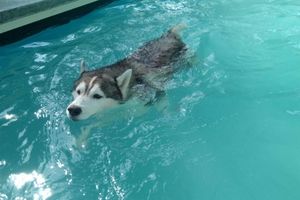Drowning is a familiar term to all of us—a traumatic event that occurs when a person or animal is submerged in water for too long and deprived of oxygen. However, a relatively uncommon but related term is secondary or "dry drowning." Water is aspirated into the lungs and causes serious complications, often hours or even days after water exposure. Dry drowning, also known as aspiration pneumonia, can affect humans and their pets. In honor of National Swimming Pool Day on July 11th and because of the considerable amount of time we spend near the water with our pets during these summer months, it's important to be aware of how dry drowning occurs and how to avoid it.
How Dry Drowning Happens
Dry drowning often shocks pet owners because it's not usually the result of a dramatic water event that requires rescuing your pet. Instead, it can happen following a quick moment of being underwater and ingesting a considerable amount of water in one big gulp. It can occur in a bathtub or any body of water, and even dogs and other pets that are accustomed to swimming often and jumping into pools can be susceptible to it. It can occur from a single moment of being submerged, with no immediate cause for concern, and your pet continues to act normal.
Signs of Dry Drowning
Hours or even days after water has entered your pet's lungs, symptoms of dry drowning can start to appear.
Signs of dry drowning in pets include:
- Coughing
- Breathing difficulties
- Wheezing
- Discomfort, especially in the chest area
- Lethargy Drooling
- Crackling sound in the chest
- Cyanosis, or bluish-colored skin and gums
If your pet was recently around water and presents any of these symptoms, take them to an emergency veterinarian, even if you overlooked submersion. Dry drowning can quickly progress to an emergency if not addressed.

Preventing Dry Drowning
Being aware of dry drowning is the first step in preventing it. Many pet owners are unaware their pets are at risk after being briefly submerged, and the symptoms of dry drowning go unnoticed.
Avoid dry drowning in your pets with the following precautions:
- Closely monitor your pet around water at all times, even if they're a good swimmer.
- Have them fitted for a life jacket to wear whenever they're around water, choosing one with these key features as outlined by the American Kennel Club.
- When swimming with your dog, be sure they possess the instinct to keep their head above water and aren't swallowing water consistently as they swim.
- If your pet had a near-drowning incident, watch them closely for several days for signs of dry drowning.
- Teach your dog how to swim and properly exit a pool when they tire.
- Avoid throwing a ball or stick into the water for your dog to fetch, as they will then swim back to you with their mouth open, which can allow water to enter the lungs.
While we want your pet to enjoy the warm summer months and all the pool, boat, and lake fun that comes with it, it's also essential that you monitor them closely to prevent a dry drowning situation. Contact us if you would like to learn more about how to prevent or watch for signs of this condition.
